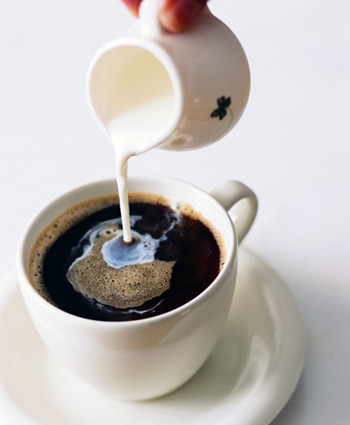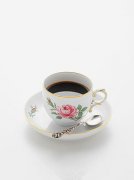Coffee is the devil's trick? Drinking coffee is a serious crime

Europeans first came into contact with coffee around 1515-1519, but were not interested in it for a long time. Thirty years after Istanbul's coffee houses appeared, in 1585, Morosini, the Vatican ambassador there, reported: "These people are all humble, dressed in vulgar clothes, and have no initiative. They just spend their time in a daze. So they just sit around and have fun, in public places, in shops, on the streets, drinking a black liquid hot enough for them to stand, squeezed from a seed they call coffee." The first impressions of Europeans at that time were mostly mixed with disgust and contempt. In 1610, George Sandys, an Englishman, wrote in his travels to Turkey about the Turks who drank coffee: "They sat there chatting all day, sipping a drink called 'coffee'... as hot as they could bear; black as coal dust, and tasting, it could not be said that they did not taste like..."
Yang Xiaokai recalled in his book "The Book of Cattle, Ghost and Snake" that when he drank coffee for the first time during the "Cultural Revolution", he found that the taste was not as good as he imagined. He frowned and smiled and said,"No wonder people in capitalist countries live very hard. It turns out that they drink such bitter things all day long." This reaction is human, and it was almost the same 400 years ago when Europeans first encountered coffee. Oddly enough, the world's most popular semi-addictive drinks (whether tea, coffee, chocolate, or cocoa) all have a bitter taste, but through cultural packaging, any bitter taste can become a fad.
Drinking coffee is a serious crime. Although coffee drinking is now often regarded as a more "upper class" behavior by Chinese people, the origin of coffee is very humble. One theory suggests coffee originated in the ancient kingdom of Kaffa in southern Ethiopia (some call it the "home of coffee"); another suggests that Kaldi, an Arab shepherd in the mountains of Yemen, discovered in 850 that his sheep were behaving abnormally after eating a dried kernel, which he then boiled to make a drink called qahwah(meaning "wine"), which was the precursor to coffee.
These two statements seem to differ from each other on the surface, and there are different explanations for the origin of the word "coffee", but they all admit that coffee originated in the Horn of Africa region, although this area is extremely poor and backward now, but there are close ancient civilizations in ancient times, so it is likely that coffee was introduced into Yemen from Ethiopia across the sea. One strong reason is that in Ethiopia's Kaffa region coffee was called buno, which later evolved into the Arabic bunn(meaning "raw coffee"), suggesting that its origin should be in Africa.
In any case, it was the Arabs who really spread the drink. There is still a famous coffee called mocha coffee, which is named after Mocha, a Red Sea port in Yemen, which was famous for exporting coffee for a long time in the Middle Ages. According to Islam, Muslims are not allowed to drink alcohol, but coffee can be used to refresh themselves during prayer. It was initially consumed only in Yemen, but spread outward from the beginning of the 14th century, and coffee began to appear in Cairo, the center of Islamic countries in the Middle East, in 1400, and gradually spread to almost the whole Middle East. However, many people at the time had concerns about whether coffee conformed to the doctrine. Some people thought that it could be regarded as an alcoholic beverage and should be banned, and replaced by tea without any alcohol content. This idea was gradually accepted later, and the result is that tea drinking habits are now deeply rooted in the Middle East (especially as a national drink for low-income groups), and coffee can only supplement it in many cases.
The Turks, though equally converted to Islam, embraced coffee. In 1554, two Arabs from the Syria cities of Damascus and Aleppo opened the first café in Istanbul, the capital of the Turkish Empire. The Turks called this new drink kahve, and later the word "coffee" in European languages (such as French café, Italian caffè, English coffee may be translated from Italian). Coffee, as a refreshing stimulant, was extremely popular in mystical Sufi circles and influenced the habits of many Turks.
Even so, Turkish coffee-drinking habits face religious pressure. In Orhan Pamuk's historical novel My Name Is Red, the imam declares that "drinking coffee is a serious crime!" Our glorious prophet never touched a drop of coffee…He understood that coffee was a trick of the devil." Although this is fiction, it does reflect the reality of the time to some extent; by the 1630s, the imperial sultan banned coffee and tobacco-drugs that had been taboo in the pre-industrial West, but were later accepted because their refreshing effects supported "the reorientation of the human organism to the primacy of mental labor" in the process of industrialization.
Thus, as coffee gained popularity as a worldwide drink, the Arabs and Turks who first discovered and popularized the drink gradually all but stopped drinking it.
Wasted time: drinking a black liquid
Europeans first came into contact with coffee around 1515-1519, but were not interested in it for a long time. Thirty years after Istanbul's coffee houses appeared, in 1585, Morosini, the Vatican ambassador there, reported: "These people are all humble, dressed in vulgar clothes, and have no initiative. They just spend their time in a daze. So they just sit around and have fun, in public places, in shops, on the streets, drinking a black liquid hot enough for them to stand, squeezed from a seed they call coffee." The first impressions of Europeans at that time were mostly mixed with disgust and contempt. In 1610, George Sandys, an Englishman, wrote in his travels to Turkey about the Turks who drank coffee: "They sat there chatting all day, sipping a drink called 'coffee'... as hot as they could bear; black as coal dust, and tasting, it could not be said that they did not taste like..."
Paris opened its first café about 100 years after Istanbul, and London did the same. When London's first coffeehouse opened in 1652, it was met with a storm of protest from supporters of the English beer industry, who declared the "pagan drink" to be "inferior, dark, thick, dirty, bitter, smelly, and disgusting muddy water." Even in 1925, the word mud was invented as a slang term for coffee. Nevertheless, cafes soon proliferated: by 1675 there were more than 3000 in England, an average of 130 new cafes a year; France was slower, with only about 2800 by the 1780s, but the impact was equally profound, because France was a bellwether of European fashion at the time.
Just as coffee houses in China today are often designed in European style, the interior and general atmosphere of London coffee houses were designed and built in the style of traditional Arabic coffee houses until the end of the 17th century. Coffee was at first "horribly expensive"(though not because it was precious or inconvenient to transport, but because of exorbitant tariffs), but it was still cheaper than tea and fell rapidly; although tea was introduced to Europe a few years earlier than coffee, tea had a far less profound impact on European life throughout the seventeenth century, in part because tea drinks were so expensive. By the end of the seventeenth century, tea prices had fallen somewhat under the impact of cheap coffee, but a cup of tea still cost five times as much as a cup of coffee.
The appearance of coffee houses has profoundly changed the living space of Western Europeans. In countries such as Britain and France in the 18th century, coffee houses were revered places, clearly of higher social status than small bars. And as is customary in places like the Middle East, cafes are reserved for male clientele, men who come for business or rest, so much so that they naturally assume a club-like character. As the sociologist Pierre Bourdieu describes it in The Bachelors 'Ball, some parts of southern France still do: cafes are primarily meeting places for men."When women want to call their husbands, they don't go to the cafes themselves, but send their sons."
Socially, the cafe is a bit like the teahouse in China: it creates a communal space, levelling class distinctions and allowing people of all classes to have a drink and engage in gossip as prices fall. Sociologist Lewis Coser argues that this "fosters a new respect and tolerance for the ideas of others," promoting social atmosphere and conversational communication that in effect become clubs. However, in different countries, cafes have different styles. In contrast to France, where, according to some Britons,"coffeehouses are crowded with intellectuals, smoking, drinking coffee, and coming up with impractical ways to transform the universe," the British are much more pragmatic: Lloyd's Register, originally the ship insurance agency of a London coffeehouse, is named after Edward Lloyd(1648-1713), the founder of the coffeehouse.
After two hundred years of development, by the end of the 18th century coffee was no longer generally regarded as a Muslim drink or "muddy water", but as one of the symbols of social identity, a necessity of Western European life-it became a drink symbolizing "civilization".
Brothels are often disguised as cafes
By the late nineteenth century coffee, once considered an imported luxury, had become commonplace in many parts of Western Europe. Behind this, of course, was first the enormous development of the relevant industries (which required the maintenance of large-scale coffee plantations and trade systems), and second the widespread acceptance as part of social etiquette. It became in fact an integral part of Western life (hence the desire of the French middle class for peace at sea during the Napoleonic Wars in the hope that coffee prices would fall) and became something of a symbol of Western lifestyle.
After coffee was introduced into Europe, it itself underwent many changes, adding many new elements: for example, Europeans liked to add sugar to coffee.(Arabs never did); Italians invented cappuccino by mixing milk and cream with strong coffee-its etymology coppuccio originally meant a long, pointed cloak similar in color to this coffee worn by the pious Capuchin monks of the Franciscan branch; French Parisians mixed coffee, milk and sugar. Although by the end of the 19th century the average British person consumed ten times as much tea as coffee, coffee was increasingly seen as a Western fad, largely driven by the French.
Ironically, it is the popularity of this drink that has changed the lives of many people in other parts of the world. In Africa, Latin America, and tropical Asia, large areas of land were forcibly converted to coffee plantations, and many colonial economies depended primarily on coffee exports for their sustenance. In Indonesia, coffee was the dominant export commodity for most of the 19th century; in Brazil, coffee exports amounted to 61 percent of total exports in the 1880s, and this vast coffee-production system shifted the center of activity completely to the south-central part of the country, eventually making the decline of northeastern Brazil inevitable.
In other areas, with the penetration of Western culture, the sight of upper-class people resting, discussing, and reading in cafes gradually became a symbol of a desirable lifestyle. The first to be affected outside Western Europe were the Germans of Central Europe, who, while hating the French, adopted their cafe culture. Coffee was a luxury for Germans at first, but soon craftsmen in Württemberg could not afford anything but potatoes,"but if they were forced to give up morning coffee, they would think they were living an inhuman life." This even led to a kind of "unrequited love" for French culture, so much so that after the First World War began, Wyndham Lewis ridiculed the war as "strange courtship" in "Upwind":"The real German must go to Paris, to the cafes of Paris, at all costs, even if he leads an army and kills millions."
In Russia, as in Japan, coffee houses have emerged in cities with the wave of Westernization, becoming new places of public entertainment and opening up a space for people to accept new values. They were not necessarily "civilized" and sometimes even appeared to be criticized. For example, brothels in the pre-1937 Shanghai Concession were often disguised as cafes, bars, dance restaurants, photo studios, dance schools, etc., which were considered by some conservative people to be immoral places. But even so, one thing is certain: they represent a new way of life, a "modern" thing that may be different from the conservative cultural traditions of the place. For a long time, therefore, coffee houses were regarded in China as places for fashion-seeking young people-Qiong Yao's later novels often took place in three fairly fixed places, the living room, the ballroom and the coffee shop, thus being ridiculed as "three hall movies."
There is no doubt that for many people, drinking coffee is not just about drinking the beverage itself, but also consuming all the cultural symbols associated with the beverage. If coffee had always been a kind of "muddy water" drunk by Arabs and Turks, many Chinese probably would not have chosen it, even if it still tasted the same. This is the great power of cultural construction-it can make the thing consumed seem unimportant, but the symbol itself: does drinking coffee seem like a symbol of social taste? Though we lift the veil, we sometimes look little different from the "cheesy, unambitious" Turks of four hundred years ago.
Important Notice :
前街咖啡 FrontStreet Coffee has moved to new addredd:
FrontStreet Coffee Address: 315,Donghua East Road,GuangZhou
Tel:020 38364473
- Prev

Ten wonderful truths about coffee all started with dancing goats.
It all started with dancing goats. According to legend, an Ethiopian shepherd named Caldi discovered the coffee plant. In the process of herding the sheep, he found that when the goat ate a kind of fruit from the coffee tree, it would be very excited and strange, so he tried to eat some. Then a monk found Caldi full of energy and asked him.
- Next

Coffee culture and etiquette have no taboos in American style
When Americans drink coffee, it is like playing a game without rules, laissez-faire without taboos. Americans are dismissive of all kinds of exquisite coffee made by Europeans. Americans drink coffee freely, and at the same time, coffee goes deep into their lives and is difficult to separate, and the influence is so deep that it is not considered a life without coffee. It is said that Apollo carried a man to the moon for the first time.
Related
- How did the Salvadoran coffee industry develop in Central America?
- What exactly does the golden cup extraction of coffee mean?
- The Origin of Coffee flower
- [2023 Starbucks World Earth Day] there are more meaningful things besides free Starbucks coffee!
- What kind of coffee is there in Spain? 9 Flavors of Spanish Coffee
- Aromatic African coffee| Kenya's coffee culture and historical production area
- Liberica Coffee Bean knowledge: the characteristics of Liberian Coffee beans of the three original species of Coffee beans
- The origin and formula of Spanish latte introduces the taste characteristics of Bombon coffee in Valencia, Spain.
- How to adjust the solution of over-extracted coffee
- What is the tasting period of coffee beans? What is the period of coffee and beans? How should coffee wake up and raise beans?

